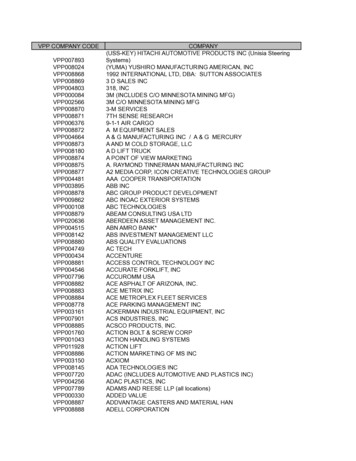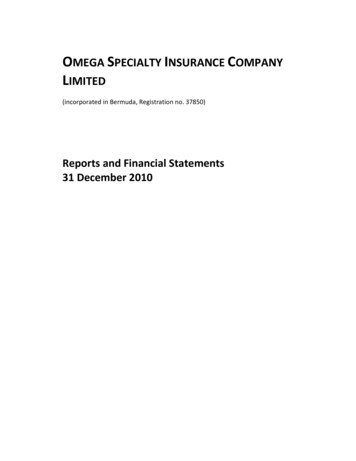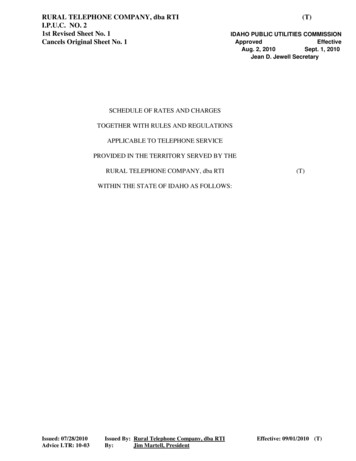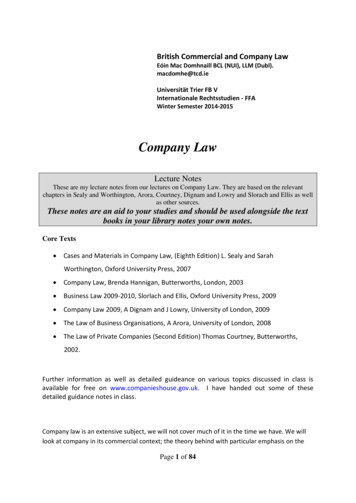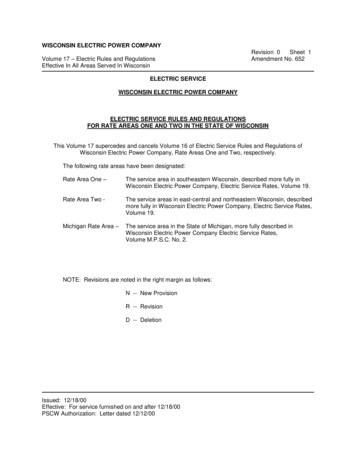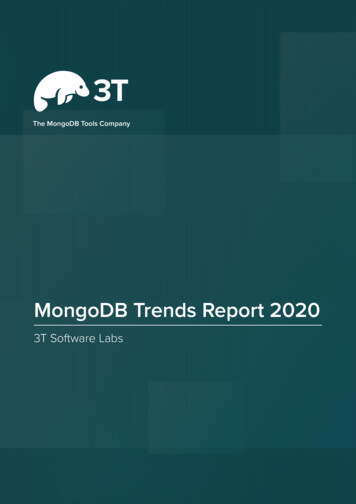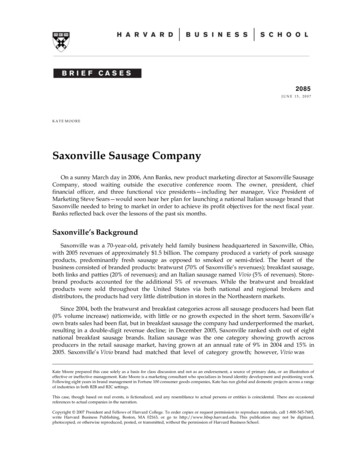
Transcription
2085JUNE 15, 2007KATE MOO RESaxonville Sausage CompanyOn a sunny March day in 2006, Ann Banks, new product marketing director at Saxonville SausageCompany, stood waiting outside the executive conference room. The owner, president, chieffinancial officer, and three functional vice presidents—including her manager, Vice President ofMarketing Steve Sears—would soon hear her plan for launching a national Italian sausage brand thatSaxonville needed to bring to market in order to achieve its profit objectives for the next fiscal year.Banks reflected back over the lessons of the past six months.Saxonville’s BackgroundSaxonville was a 70-year-old, privately held family business headquartered in Saxonville, Ohio,with 2005 revenues of approximately 1.5 billion. The company produced a variety of pork sausageproducts, predominantly fresh sausage as opposed to smoked or semi-dried. The heart of thebusiness consisted of branded products: bratwurst (70% of Saxonville‘s revenues); breakfast sausage,both links and patties (20% of revenues); and an Italian sausage named Vivio (5% of revenues). Storebrand products accounted for the additional 5% of revenues. While the bratwurst and breakfastproducts were sold throughout the United States via both national and regional brokers anddistributors, the products had very little distribution in stores in the Northeastern markets.Since 2004, both the bratwurst and breakfast categories across all sausage producers had been flat(0% volume increase) nationwide, with little or no growth expected in the short term. Saxonville‘sown brats sales had been flat, but in breakfast sausage the company had underperformed the market,resulting in a double-digit revenue decline; in December 2005, Saxonville ranked sixth out of eightnational breakfast sausage brands. Italian sausage was the one category showing growth acrossproducers in the retail sausage market, having grown at an annual rate of 9% in 2004 and 15% in2005. Saxonville‘s Vivio brand had matched that level of category growth; however, Vivio wasKate Moore prepared this case solely as a basis for class discussion and not as an endorsement, a source of primary data, or an illustration ofeffective or ineffective management. Kate Moore is a marketing consultant who specializes in brand identity development and positioning work.Following eight years in brand management in Fortune 100 consumer goods companies, Kate has run global and domestic projects across a rangeof industries in both B2B and B2C settings.This case, though based on real events, is fictionalized, and any resemblance to actual persons or entities is coincidental. There are occasionalreferences to actual companies in the narration.Copyright 2007 President and Fellows of Harvard College. To order copies or request permission to reproduce materials, call 1-800-545-7685,write Harvard Business Publishing, Boston, MA 02163, or go to http://www.hbsp.harvard.edu. This publication may not be digitized,photocopied, or otherwise reproduced, posted, or transmitted, without the permission of Harvard Business School.
2085 Saxonville Sausage Companyavailable in just 16% of the nation‘s large supermarkets, primarily in Boston, New Jersey, New York,Maryland, and South Carolina.Upon hiring Ann Banks in the fall of 2005, Steve Sears assigned her to assess ―the Italianopportunity‖ for Saxonville and develop a national product under the Vivio name or as a new brand.Coming from a Fortune 100 packaged goods company, with experience in brand identity anddevelopment work, Banks was eager to ―make her mark‖ in a smaller organization. In their firstconversation, Sears had told Banks, ―Your portfolio shows that you don‘t just rely on developing adistinctive product; you know how to match up core values in the ‗hearts and minds‘ of consumerswith the attributes of a product, so that consumers feel like the brand was designed specifically tomeet their needs. Saxonville needs a well-thought-out positioning plan if we want to move from ouralso-ran position in Italian sausage to national category leader and make our product one that everymajor grocery account in the U.S. will want to carry.‖Background of Saxonville’s Italian Sausage BusinessBanks soon found a willing guide to Saxonville‘s business and a partner for her project in LauraBishop, director of market research. Bishop gave Banks the results of Saxonville‘s Attitude andUsage research in 2001 and access to the company‘s constantly updated, online market database.In their first lengthy conversation, Bishop frankly explained Saxonville‘s challenges. ―In thebreakfast category we just don‘t spend enough to compete with the big players. Besides, fewer peopleare serving sausage for breakfast; it‘s eaten more at special occasions, typically on weekends.‖ Shecontinued. ―The bratwurst division fired their ad agency mid-year. Then it was too late to get a newcampaign developed and fielded. Steve knows we need to change the marketing planning for brats.‖Bishop smiled, ―But think about the potential for brats—they‘re mainly prepared at outdoorbarbeques, and there‘s only so much outdoor grilling. People eat inside more often.‖―About Vivio. Saxonville first entered the Italian sausage market in 2002 in the Northeast where,‖Bishop laughed, ―brats are not a basic staple like here in the Midwest. They made up an ‗Italian‘name because senior management worried that people wouldn‘t buy an Italian product from a‗German heritage‘ company. Vivio was priced comparably to other regional Italian sausages, and wegave it the required trade support. For Vivio‘s first six months, it went on deal every other month, andalso offered some in-store sampling. Shoppers tried it at a discounted price, and a brand was born, atrelatively little cost.‖ She beamed. ―The product is great. Now the trade in those areas knowsSaxonville the company, and we‘ve established relationships to allow the introduction of brats to theeastern United States.‖―But,‖ Banks asked, ―what about positioning the Vivio brand? What did the company do to createa distinctive identity for Vivio that would stand out amid the competition?‖Bishop responded: ―Not a lot. We used a Styrofoam tray covered in plastic wrap, with a labeldepicting coiled links of sausage next to a head of garlic and an old-fashioned sausage grinder. Thelabel covers most of the package, leaving enough space so you can see the ‗look‘ of the sausageinside. It says ‗Vivio fresh Italian sausage‘ and has an Italian flag in one corner. That was thepositioning—the product was basically lobbed out there.‖Bishop continued. ―Regional competitive brands are positioned one of two ways. Some brandslike Mama Mia in New York emphasize ‗authentic Italian heritage‘—our implied angle for Vivio.2BRIEFCASES HARVARD BUSINESS SCHOOL
Saxonville Sausage Company 2085Others, like Hertfordshire in Pennsylvania, say ‗freshly and locally made.‘ Paglia Brothers in Bostontries to do both: they have an Italian name but work the ‗locally grown‘ angle.‖―Some brands do a little local spot advertising, some TV or radio; others advertise trade deals innewspapers and store circulars. Pretty basic stuff. We‘ve only supported the brand with base tradespending,1 but slowly and surely it‘s making distribution gains. Field reps report that majorsupermarket accounts in different areas request Vivio to stay competitive. In a number of accounts,the brand has gained multiple facings.2 Other Italian sausage brands have been pulling consumersin, and Vivio’s growing along with the category.‖ However, Bishop admitted that Saxonville had notyet conducted market research on the Italian sausage customer, because senior management felt thebusiness was growing just fine without research and was skeptical of positioning (―one of thosebusiness-school buzz words‖).Researching and Evaluating the Italian OpportunityAfter that meeting with Bishop, Banks spent a week reading through the past 10 years ofSaxonville‘s market research results along with the brands‘ annual business plans and year-endreports. Then, with her manager Sears‘ assistance, she formed a multifunctional task force thatwould provide input and perspective in her investigation of the Italian sausage opportunity. Theteam, who named their task ―Project Score,‖ included 10 colleagues from the research anddevelopment (R&D), packaging and graphics, marketing, and sales departments.At the meeting, Banks handed out two documents. The first was a one-page summary of thecompany‘s sausage businesses (see Exhibit 1). She wanted the team to understand Italian sausage inthe context of the whole portfolio, partly to reduce the risk that future positioning of Vivio mightinadvertently encourage cannibalization of the other products. The second document presentedVivio‘s 2005 sales performance (Exhibit 2) and showed the brand‘s available line items by form andflavor. Banks asked for the team‘s comments and perceptions of the ―Italian opportunity.‖ Thenational sales manager immediately spoke up, arguing that Italian sausage had untapped potentialwith male cooks who might make it a grilling staple for weekend barbecues. Vivio‘s marketingstrategy, he believed, should dissuade these grillers from substituting Vivio for bratwurst.Banks then asked the team, ―Why has no one realized the opportunity to develop a nationalItalian sausage brand?‖ This time Bishop responded: ―These local brands have played up their ‗homegrown‘ heritage—the whole farm-to-market idea. Plus, there‘s a reluctance to think creatively abouthow to distribute outside your core geography.‖ Banks mused, ―There‘s the trap. Pick a ‗local‘positioning, and who are you, if you leave your home turf?‖ She pushed further. ―What about one ofthe national giants like Billy Bob or Country Home?‖ This time the national sales manager responded.―Ann, those guys are frozen producers, not fresh. There is some overlap, but predominantly theirdistributors drive freezer trucks. It would mean reconfiguring their whole distribution network toplay in this category.‖ Finally Banks was satisfied and she moved the meeting on to describe themethodology they would use to research the Italian sausage consumer.―There are numerous ways to do positioning work. Typically I follow a four-step process. Thefirst is a round of qualitative research with target consumers to understand their behaviors andneeds. The second step is a sequential round of consumer sessions, where we‘ll use the language1 Money given to retailer accounts to put the product on deal (i.e., at a sale price) and to pay for space in the refrigerator case.2 A facing is the first in a stack or row of packages on a supermarket shelf or in a freezer or refrigerator case.HARVARD BUSINESS SCHOOL BRIEFCASES3
2085 Saxonville Sausage Companywe‘ve heard to develop and then gain reactions to different positioning ideas. In the third round werefine all the new learning into actual concepts and have consumers prioritize and improve them. Inthe fourth step, the concepts are put through monadic 3 testing, and in the end, among other things,we look at the purchase intent scores the testing generates. The three qualitative steps will give usdepth and help to surface ideas, while the quantitative piece will validate those ideas across abroader population. To succeed, I believe a brand must find a way to link its product to the corevalues of their target consumers. When a brand taps into what really matters to customers,customers feel good about using that brand.‖Banks ended the meeting saying, ―There‘s one other important question we hope the research canhelp us with. What is the ideal name for Saxonville‘s line of Italian sausage? Should a nationalentrant continue with the Vivio brand name, or have a different Italianate name, or utilize theSaxonville name to leverage the company‘s heritage and brand equity?‖Step One: Planning New Research on the Target CustomerFor the initial phase of research Banks and Bishop ran four highly interactive ―mini‖ pilot groupsout of a Pennsylvania research facility to get a quick handle on what current Italian sausage users hadto say about their use of the product. Each group contained four to six users—men and women aged25-50—who used either branded or store-brand products. The work served to confirm (or not, insome cases) some of the basic information presented in the Attitude and Usage (A&U) data, and itgave Banks and Bishop an idea of the language consumers used to discuss some of the benefits Italiansausage delivered.In October 2005, Banks and Bishop began Phase II of the process, engaging two additionalcolleagues: Liz Keller, a top brand consultant, and a professional from a marketing research companythat had local focus group facilities across the country. Over the next five weeks, Keller worked withBanks and Bishop to develop stimulus materials and a guide for moderating the sessions, whileBishop managed the research company as they simultaneously recruited, screened, and selectedconsumers for the focus groups to be conducted in selected locations. To decide which criteria thescreener should use for recruiting participants, Banks and Bishop pored over Saxonville‘s A&U data(see Exhibit 3). To keep the number of groups manageable and economically feasible, they had tomake decisions about age of consumer, brand use, and other characteristics. Banks had explained herpriorities to Keller: ―Liz, we‘re coming with an empty plate. In this initial phase we need tounderstand current behaviors, triggers to purchase, and unmet needs; to get a clear understanding ofproduct benefits, attributes and ideals; and to develop a solid feel for core values and the role thisproduct plays, or can play, in these people‘s lives.‖At the end of November 2005, Banks and Bishop headed to their first focus group sessions in NewBrunswick, New Jersey. The research company had initially cold-called 437 female heads-ofhousehold and screened them to participate; of this total
Saxonville Sausage Company On a sunny March day in 2006, Ann Banks, new product marketing director at Saxonville Sausage Company, stood waiting outside the executive conference room. The owner, president, chief financial officer, and three functional vice presidents—including her manager, Vice President of Marketing Steve Sears—would soon hear her plan for launching a national Italian .
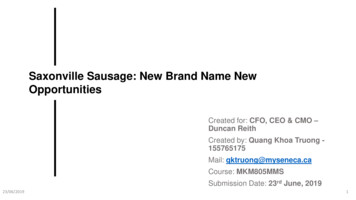
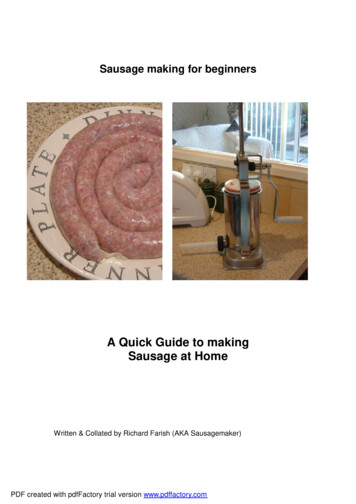
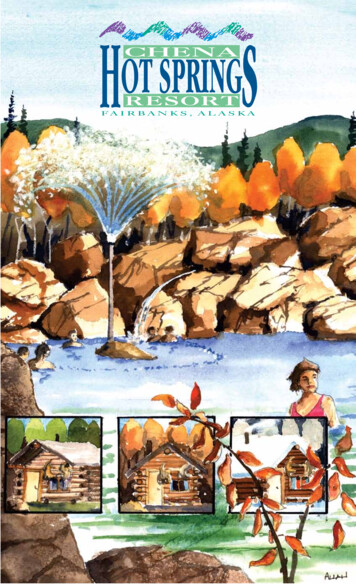

![Shareholders’ Agreement of [Company name] company. 1 .](/img/1/startup-founders-sha-sample.jpg)
